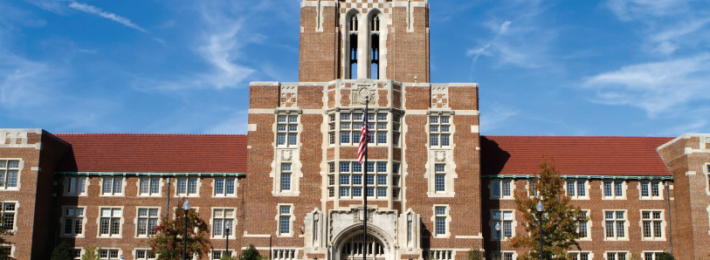
Managing the student life cycle requires cross-divisional initiatives and the willingness to innovate. Applying a student success lens to the student life cycle has led institutions to examine the relative roles played by traditional measures of academic achievement (grades, credits completed, major requirements met) and less traditional, non-cognitive indicators such as student grit and resilience. This shifting approach is leading to intentional campus initiatives designed to foster attitudes and behaviors that will promote student success—as measured by higher retention, graduation, and student satisfaction rates.
For example, consider the programming offered by the Office of Undergraduate Retention at the University of North Carolina at Chapel Hill. Recognizing that today’s college students live their daily lives on their devices, the UNC-CH retention office website is stocked with descriptions of workshops on, and suggestions for further exploration of, topics such as developing a growth mindset, thinking positively amidst change, and becoming resilient.
Similarly, the Student Success Advocates program at the University of Utah provides video resources for students, with titles that include: Growth Mindset;” “Change Your Mindset, Change the Game;” and “Ability, Effort, or Mindset?”
There is increasing evidence that such factors matter. A recent Rice University study, for example, found clear evidence that students at four-year colleges get better grades and are more likely to graduate if they exhibit three key traits:
- A growth mindset (belief that their intelligence can improve over time).
- A sense of belonging and social integration into campus life (flagged as especially important for underrepresented students).
- An intrinsic motivation to achieve.
The Rice research team found that 83% of the retention and completion studies examined showed strong evidence that these three non-cognitive factors led to higher rates of student success. Further, the study found that retention and graduation rates can be positively impacted by low-cost and relatively simple interventions that develop and strengthen resilience-correlated characteristics such as internal motivation. Such findings underscore the fact that universities need to think not just about how to recruit resilient students but also how to build the resilience of the students they have enrolled, both to help those students persist through graduation and depart their alma mater better prepared for life, career, and citizenship.
Examples of Resilience-Building Initiatives
At institutions across the country, we are seeing the emergence of both student-initiated activities or programs (in which students highlight for each other the need to persevere amidst adversity) and cross-campus initiatives designed to educate students about ways to build their resilience and grit. For example:
A Student Video
A recently-released video by Cornell University first-year student Emery Bergmann drew attention to how incoming students can get upended by loneliness. The message of Bergmann’s video, which went viral, is that first-year students need to recognize that there is no shame in loneliness, that it is something countless others are experiencing.
Bergmann’s video came as an apt follow-on to Frank Bruni’s New York Times op-ed that put a spotlight on the ubiquitous (and hardly new) condition of first semester of college loneliness (“The Real Campus Scourge,” September 2, 2017). The implication of Bergmann’s video and Bruni’s article is that navigating first semester loneliness is one of the first tests of resilience that new college students face.
A Resilience Cooperative
At Tulane University, the Undergraduate Student Government operates a Resilience Cooperative, whose goal is to help students develop the skills needed to achieve when they encounter adverse conditions. Central to Tulane’s student-run Resilience Cooperative is a belief in the power of a “growth mindset” and qualities (such as persistence) associated with Angela Lee Duckworth’s concept of “grit.”
Tulane’s Resilience Cooperative invites students to redefine failure as an inevitable and potentially instructive stage in the ongoing process of learning and growth that occurs in college and beyond. The overall goal of the Tulane Resilience Cooperative is to shift the perception of failure on campus from something to be avoided to something that can teach students valuable lessons.
“Story of Failure”
Similarly, the Office of Retention and Student Success at Tulane encourages students to “share their own personal stories of resilience.” Under its “Story of Failure” project, Tulane provides students with topic prompts such as: culture shock, imposter syndrome, responses to criticism, and career path uncertainty. By highlighting resilience stories, Tulane’s Retention and Student Success office hopes to normalize failure so that students will come to understand that they can be successful even when encountering unexpected obstacles that appear insurmountable. The goal of initiatives like this one at Tulane is to grow student resilience and increase student agency, confidence, and determination.
The Student Onboarding Experience
To more effectively deliver on student expectations, the academic units, enrollment offices, and the campus life division at Emory are working as partners on the Emory Undergraduate Experience Initiative (EUEI). Two recently launched efforts under EUEI include:
- A cross-campus working group charged with improving the new student onboarding experience.
- The one-credit, one-semester PACE 101 course for first-year students; besides curricular requirements and academic policies, the PACE 101 curriculum includes discussion of how to build resilience–for example, by exploring new areas and risking the prospect of failure.
Individualized Resiliency Coaching
At Notre Dame College in Metro Cleveland, where nearly 40% of the approximately 2,100 students are the first in their family to attend college, there is a dedicated First Generation Center that provides students with individualized resiliency coaching. Devised based on student success research findings, the approaches taken by the Notre Dame resiliency coaches aim to help students develop, and then learn to practice, the characteristics of perseverance, determination, and grit. Students assisted by the Notre Dame First Generation Center also quickly come to realize (and take solace from) the fact that they are not alone in facing the challenges inherent in breaking from their family’s history and trailblazing a path to a college degree.
Case Study: Morrisville State’s Use of the Student Strengths Inventory (SSI)
Morrisville State University, an agricultural and technical college of the State University of New York, is taking the next step with a rigorous research initiative. Dean of Enrollment Robert Blanchet has turned to the student strengths inventory (SSI), a survey instrument designed to measure non-cognitive student characteristics, such as academic self-efficacy, resilience, social comfort, campus engagement, educational commitment, and discipline. Over the summer of 2017, Blanchet and his team at Morrisville began to collect SSI data from incoming freshman. Using that data, Blanchet will undertake a statistical analysis that measures the degree to which each of the SSI’s non-cognitive characteristics influence academic success and retention at the college.
Blanchet chose this approach because his past research before joining Morrisville State suggested that a student’s willingness to engage in campus activities predicts a higher likelihood of retention. Blanchet further found that students who demonstrate willingness to deeply engage in extracurricular activities in high school are more likely to do the same (and persist to graduation) while in college.
While Blanchet and his team at Morrisville are mining and analyzing a year’s worth of data on the newly enrolling students, the college will be modifying its admissions review practices to put greater emphasis on each applicant’s record of “community and extracurricular” engagement. To do this, Morrisville’s admissions office will start measuring the breadth and depth of student engagement using application essays, student resumes, and college interviews. Once in place, Morrisville’s newly-modified approach to application review will be used for all applicants. It is Blanchet’s expectation that the admissions committee’s examination of community and extracurricular engagement will be especially critical in helping predict the success of “borderline” applicants.
At one point, Blanchet considered going further by adding a required survey or questionnaire to Morrisville’s supplemental admissions application. But then he realized that such a survey would be difficult to administer in a way that would elicit valid answers. Some students (perhaps even many), Blanchet surmised, would understand that their responses were being measured as part of the application review and, thus there might be a tendency to provide “desirable” answers that would help them get admitted.
What’s Next?
What directions might there be for future research or future initiatives? I would like to suggest a few.
Pilot New Student Onboarding Programs
At colleges in the U.S., roughly 40% of new student orientation programs require a common reading assignment that gets discussed. According to the University of South Carolina’s National Resource Center for First-Year Experience and Students in Transition, institutions that require a common reading assignment range from public flagship universities like the University of Vermont and the University of Wisconsin at Madison to small liberal arts colleges such as Gustavus Adolphus and Williams. Why not use these required readings in an intentional way to signal to incoming students the significance of resilience and grit?
Such an idea has its proponents. Former chemistry professor and current parent of a college student, Phil Ortiz, the Assistant Provost for Undergraduate and STEM Education for the State University of New York System, would like to see more campuses use their common reading assignments to help create a resilient mindset among incoming first year and transfer students. The mindset Ortiz envisions would be focused on self-efficacy and intrinsic motivation. He sees an opportunity for campuses to work such an approach into their orientation programs for all new students, not just for incoming freshmen.
Potentially, an institution could approach such an effort on an experimental basis, that would compare retention and graduation rate performance of groups assigned such readings with control groups that are not.
Investigate the Impact of Non-Cognitive Factors at Community Colleges
Another area for inquiry involves an extension of the Rice retention and completion study. Because that study focused only on students at four-year colleges, there is an opportunity for further research to determine whether having a growth mindset, a sense of belonging, and intrinsic motivation correlates with student success at community colleges. Given the variability in ages of the students at community colleges, as well as the extent to which students are commuters or part-timers, it would be instructive to look at how some of those student characteristics align with resilience and success.
Closing Thoughts
Overall, there is much room for further study of resilience-focused initiatives designed to improve student success. As new programs get launched, it will be interesting to see if universities take their own resilience-related advice and risk that some of these programs will fail — or simply stick to the time-worn belief that only fully-vetted and seemingly fail-safe programs are worth attempting. We most definitely know which approach aligns more with the principles of resilience.
MORE FROM PAUL MARTHERS ON MANAGING THE STUDENT LIFECYCLE
Looking at Student Grit and Resilience – from Recruitment to Retention
Improving Student Success Can’t Be a One-Office Effort
Developing a Metrics-Driven Culture within Student Affairs
It’s Not Just About the First and Second Year of College


